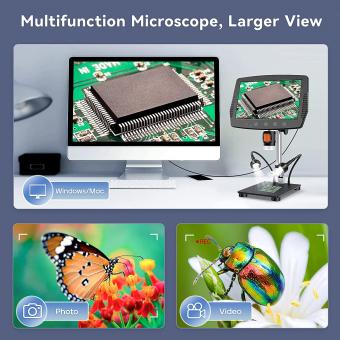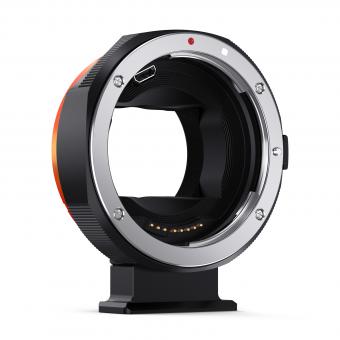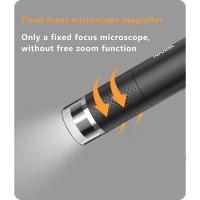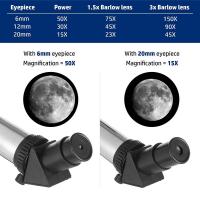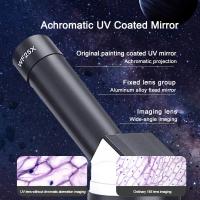Can We See Atoms With An Electron Microscope ?
Yes, it is possible to see atoms with an electron microscope. Electron microscopes use a beam of electrons instead of light to create an image, which allows for much higher magnification and resolution than traditional optical microscopes. By focusing the electron beam onto a sample, the electrons interact with the atoms in the sample, producing an image that can reveal the atomic structure. However, it is important to note that the process of imaging atoms with an electron microscope can be challenging and requires specialized techniques and equipment. Additionally, the sample must be prepared in a way that preserves the atomic structure and minimizes damage from the electron beam.
1、 Electron Microscopy
Yes, we can see atoms with an electron microscope. Electron microscopy is a powerful tool that uses a beam of electrons to image the structure of materials at the atomic scale. The resolution of electron microscopy is much higher than that of light microscopy, which is limited by the wavelength of visible light.
In fact, the first direct observation of atoms was made using an electron microscope in 1931 by Max Knoll and Ernst Ruska. Since then, electron microscopy has been used to study a wide range of materials, from metals and semiconductors to biological molecules and cells.
The latest development in electron microscopy is the introduction of aberration-corrected electron microscopy, which has pushed the resolution limit to sub-angstrom levels. This technique allows us to see individual atoms and even the arrangement of atoms in a crystal lattice.
However, it is important to note that electron microscopy has its limitations. The sample needs to be thin enough to allow electrons to pass through, and the electron beam can damage the sample. Also, electron microscopy cannot provide information about the chemical composition of the sample, which requires additional techniques such as energy-dispersive X-ray spectroscopy.
In summary, electron microscopy is a powerful tool that allows us to see atoms and study the structure of materials at the atomic scale. The latest development in aberration-corrected electron microscopy has pushed the resolution limit to sub-angstrom levels, opening up new opportunities for research in materials science, nanotechnology, and biology.

2、 Atomic Resolution Imaging
Yes, we can see atoms with an electron microscope. Electron microscopes use a beam of electrons instead of light to create an image, allowing for much higher magnification and resolution. With the development of advanced electron microscopy techniques, it is now possible to achieve atomic resolution imaging, which allows us to see individual atoms and their arrangement in materials.
Atomic resolution imaging has revolutionized our understanding of materials science, allowing us to study the structure and properties of materials at the atomic level. This has led to the development of new materials with improved properties, as well as advances in fields such as nanotechnology and electronics.
However, it is important to note that atomic resolution imaging is not without its limitations. The electron beam used in electron microscopy can damage the sample being imaged, and the imaging process can be affected by factors such as sample preparation and imaging conditions. Additionally, while atomic resolution imaging allows us to see the positions of atoms, it does not provide information about their chemical identity or bonding.
Despite these limitations, atomic resolution imaging remains a powerful tool for materials science research, and ongoing developments in electron microscopy techniques are likely to continue pushing the boundaries of what we can see and understand at the atomic level.

3、 Scanning Tunneling Microscopy
We can see atoms with both an electron microscope and Scanning Tunneling Microscopy (STM). Electron microscopes use a beam of electrons to create an image of the sample, and they have a resolution of about 0.1 nanometers, which is small enough to see individual atoms. However, electron microscopes can only be used to image samples that are thin enough to allow electrons to pass through them.
On the other hand, STM is a technique that can be used to image individual atoms on the surface of a material. STM works by scanning a sharp metal tip over the surface of the material, and measuring the flow of electrons between the tip and the surface. By measuring the flow of electrons, STM can create a three-dimensional image of the surface, with atomic resolution.
The latest point of view is that STM has become an essential tool for studying the properties of materials at the atomic scale. It has been used to study a wide range of materials, including metals, semiconductors, and even biological molecules. STM has also been used to manipulate individual atoms and molecules, opening up new possibilities for nanotechnology and quantum computing.
In conclusion, both electron microscopes and STM can be used to see atoms, but they have different strengths and limitations. Electron microscopes are better suited for imaging thin samples, while STM is better suited for imaging surfaces with atomic resolution. Both techniques have revolutionized our understanding of the atomic world and have opened up new avenues for scientific research.

4、 Transmission Electron Microscopy
Yes, we can see atoms with a Transmission Electron Microscope (TEM). The TEM uses a beam of electrons to image the sample, and the electrons interact with the atoms in the sample to produce an image. The resolution of the TEM is much higher than that of a light microscope, allowing us to see individual atoms.
However, there are some limitations to using a TEM to image atoms. One limitation is that the sample must be very thin, typically less than 100 nanometers thick, in order for the electrons to pass through and produce an image. This can be challenging for some materials, and may require specialized sample preparation techniques.
Another limitation is that the electrons used in the TEM can damage the sample, particularly if the beam is too intense or the exposure time is too long. This can limit the types of samples that can be imaged, and may require careful optimization of the imaging conditions.
Despite these limitations, the TEM remains a powerful tool for imaging atoms and studying the structure and properties of materials at the atomic scale. Recent advances in TEM technology, such as aberration correction and in-situ imaging, have further expanded the capabilities of this technique and opened up new avenues for research.













